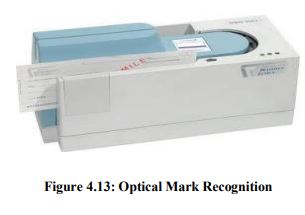4.6 Source Data Entry Devices
Entry of data into a computer system directly from the source, without transcription is
called source data entry. Source data entry devices have a lower probability of error in
input data than standard keyboard entry.
Some of the common source data entry devices are discussed below:
4.6.1 Digital Camera
A Digital camera is an electronic device which takes video or still photographs or both,
digitally by recording images via an electronic image sensor. Digital cameras can do
things which film cameras can’t, for example displaying images on screen immediately
after they are recorded
Images recorded on a digital camera can be cropped for editing, deleted and various types
of special effects can be created by using Photoshop software.
Digital cameras look like ordinary cameras but have sufficient memory in the form of
chips to store thousands of images, rather than using photographic films.
Most digital cameras allow users to choose the resolution needed for a picture. Most of
those can connect directly to a computer to transfer data. A USB port is generally used
for this purpose. A Wireless connection can also be used for connecting to a computer via
Bluetooth
These cameras use memory cards with flash memory to store images. The joint
photographing expert’s group standard (JPEG) is the most common file format used for
storing data in a camera. Other formats include raw image format, DNG format etc.
4.6.2 Scanners
A Scanner is an input device and is used to input data into the computer system in the
form of pictures. It optically scans images, printed text, handwriting, or an object, and
converts it to a digital image. Examples of scanners are a desktop or flatbed scanner.
In scanners the document is placed on a glass window for scanning. Mechanically driven
scanners that move the document are typically used for large-formatted volume of
documents.
Another type of scanner is a planetary scanner. This scanner takes photographs of books
and documents. Three dimensional scanners are used for producing three-dimensional
models of objects.
4.6.3 Optical Mark Recognition (OMR)
OMR is the scanning of paper to detect the presence or absence of a mark in a
predetermined position. Now days, it is used as an input device for source data entry
purposes. Universities and colleges often use OMR for the evaluation of OMR sheets
for competitive exams. OMR sheets consist of multiple choice question papers and
students are required to make a mark to indicate their answers. OMR is used in the
evaluation of questionnaires, surveys and university exam OMR sheets.
4.6.4 Magnetic Ink Character Recognition (MICR)
Magnetic Ink Character Recognition is a character recognition system that uses special ink and characters. When a document that contains this ink needs to be read, it passes through a machine, which magnetizes the ink and then translates the magnetic information into characters.MICR technology is used by banks for faster processing of large volumes of cheques.
Numbers and characters found on the bottom of checks (usually containing the check
number, sort number, and account number) are printed using Magnetic Ink. To print
Magnetic Ink codes, we need a laser printer that accepts MICR toner.
MICR provides a secure, high-speed method of scanning and processing information.
This technology is used for processing large volume of data. It speeds up data input for
the bank because cheques can be directly fed into the input device as it also ensures
accuracy of data entry. The most commonly used character set by MICR devices are
known as E13B font which consists of the numerals 0 to 9, and four special characters.
4.6.5 Bar Code Reader
The bar code is 13 digits long and it has four main divisions. The First two digits of a bar
code represent the country, the second part represents the manufacturer’s code (five
digits) the third part represents the product code (five digits) and the last digit is a check
digit
4.6.6 Magnetic Stripe Reade
A magnetic reader is a hardware device which is used to read the information encoded in
the magnetic stripe located at the back of a credit/debit card. A bank card holds data
about the owner of the card, bank account number and code of the bank branch, where
the account is held.
Magnetic stripe readers are often used at supermarkets and in many different types of
shops. In these machines data is read electronically and the point of sale is called
Electronic Point of Sale (EPOS).
There are several other pick devices such as microphones and speakers. These have been
discussed in length under the section Out Put Devices section of this unit.







No comments:
Post a Comment